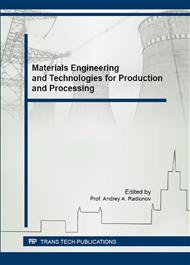[1]
Springer Handbook of Experimental Solid Mechanics / Edited by William N. Sharpe, Springer Science+Business Media, New York, (2008).
Google Scholar
[2]
N. S. Rossini, M. Dassisti, K. Y. Benyounis and A. G. Olabi, Review of Methods for Measuring Residual Stresses in Components, Materials and Design. 1 (2011) 40.
DOI: 10.1016/j.matdes.2011.08.022
Google Scholar
[3]
G. Totten, Handbook on residual stress, SEM, Bethel, (2005).
Google Scholar
[4]
G.S. Schajer, Hole-Drilling Residual Stress Measurements at 75: Origins, Advances, Opportunities, Experimental Mechanics 50 (2009) 245-253.
DOI: 10.1007/s11340-009-9285-y
Google Scholar
[5]
J. H. Underwood, Residual-stress measurement using surface displacements around an indentation, Experimental Mechanics, 13(9) (1973) 373-380.
DOI: 10.1007/bf02324039
Google Scholar
[5]
A. E. Dolinko, G. H. Kaufmann, Measurement of the local displacement field generated by a microindentation using digital speckle pattern interferometry and its application to investigate coating adhesion, Optics and Lasers in Engineering, 47 (2009).
DOI: 10.1016/j.optlaseng.2008.10.012
Google Scholar
[6]
J. G. Swadener, B. Taljat and G.M. Pharr, Measurement of residual stress by load and depth sensing indentation with spherical indenters, J. of Materials Research 16(7) (2001) 2091-2102.
DOI: 10.1557/jmr.2001.0286
Google Scholar
[7]
Nadimul H. Faisal and Rehan Ahmed, A Review of Patented Methodologies in Instrumented Indentation Residual Stress Measurements, Recent Patents on Mechanical Engineering 4 (2011) 138-152.
DOI: 10.2174/1874477x11104020138
Google Scholar
[8]
Residual Stress in Rails / Edited by O. Orringer, J. Orkisz and Z. Swiderski, Kluver Academic Publishers, Netherlands, (1992).
Google Scholar
[9]
X. Chen, J. Yan, AM Karlsson, On the determination of residual stress and mechanical properties by indentation, Mater Sci Eng. A. 416 (2006) 139-49.
Google Scholar
[10]
Apparatus and method for determining residual stress. United States Patent 6568250. http: /www. freepatentsonline. com.
Google Scholar
[11]
A. Apalkov, T. Akinfiev, M. Armada, I. Odintsev, Automatic measurement of residual stresses in the repaired details of farming machines by the coherent optics method, Engineering for Rural Development, Proc. Int. Conf. Jelgava, 27-28. 05. 2010, pp.252-255.
Google Scholar
[12]
R. Suterio, A. Albertazzi, FK Amaral, Residual stress measurement using indentation and a radial electronic speckle pattern interferometer - recent progress, J. Strain Analysis 41 (2006) 517-24.
DOI: 10.1243/03093247jsa173
Google Scholar
[13]
K. L. Johnson, Contact Mechanics, Cambridge University Press, Cambridge, UK, (1985).
Google Scholar
[14]
N. E. Dowling, Mechanical Behavior of Materials, Prentice-Hall, Englewood Cliffs, NJ, (1993).
Google Scholar
[15]
M.V. Shakhmatov, V.V. Erofeev, A. G. Ignatiev, A. A. Zarezin, Examination of residual welding stresses by holographic interferometry, Welding International 12(11) (1998) 890-893.
DOI: 10.1080/09507119809455140
Google Scholar
[16]
A. G. Ignatiev and A. A. Tretyakov, A new technique for residual stress measurements in restored parts using a cone indenter, Testing. Diagnostics, 6 (2015) 26-30.
DOI: 10.14489/td.2015.06.pp.026-030
Google Scholar
[17]
A. G. Ignatiev, M. V. Shakhmatov and A. A. Zarezin, A holographic system for measuring stresses in welded structures, Welding International 13(7) (1999) 579-581.
DOI: 10.1080/09507119909447417
Google Scholar
[18]
A. G. Ignatiev, G. P. Pyzin, M. V. Shakhmatov, Holographic measurements of residual welding stresses using optical phase compensation, Welding International 4(11) (1990) 897-899.
DOI: 10.1080/09507119009452205
Google Scholar
[19]
A. G. Ignatiev, M. V. Shakhmatov, A. A. Zarezin, Using electron speckle interferometry for measuring residual welding stresses, Welding International 13(6) (1999) 488-490.
DOI: 10.1080/09507119909447402
Google Scholar
[20]
IchirouYamaguchi, Holography, speckle, and computers, Optics and Lasers in Engineering 39 (2003) 411-429.
Google Scholar
[21]
Rajpal S. Sirohi, Speckle interferometry, Contemporary Physics 43(3) (2002) 161-180.
Google Scholar
[22]
Masakazu Shibahara, Kazuki Ikushima, Shinsuke Itoh and Toichi Fukasawa, Time-History Measurement of Welding Deformation Using Digital Image Correlation Technique, Int. J. of Offshore and Polar Eng. 2 (23) (2013) 152-159.
Google Scholar


